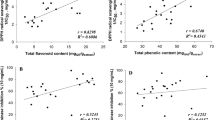Abstract
Six different parts (branch, flesh, flower, fruit, leaf, and seed) of oriental cherry (Prunus serrulata var. spontanea) were extracted with ethanol or water, then total phenol content (TPC), antioxidant activity, and tyrosinase inhibitory activity of the extracts were evaluated. The ethanol extracts showed higher TPC and antioxidant activity than the water extracts regardless of parts. The ethanol extracts of leaf as well as branch possessed superior TPC and antioxidant activity. The highest tyrosinase inhibitory activity was found in ethanol extract of leaf. There was no dramatic difference of tyrosinase inhibitory activities according to parts of cherry. The results suggest that leaf and branch of oriental cherry could be a candidate for antioxidant and anti-whitening materials in food or cosmetic industries.
Similar content being viewed by others
References
Romano AD, Serviddio G, de Matthaeis A, Bellanti F, Vendemiale G. Oxidative stress and aging. J. Nephrol. 15: S29–S36 (2010)
Imaida K, Fukushima S, Shirui T, Ohtani M, Nakanishi K, Ito N. Promoting activities of butylated hydroxyanisole and butylated hydroxytoluene on 2-stage urinary bladder carcinogenesis and inhibition of Γ-glutamyl transpepidase-positive foci development in the liver of rats. Carcinogenesis 4: 895–899 (1983)
Škerget M, Kotnik P, Hadolin M, Hraš AR, Simoniè M, Knez Ž. Phenols, proanthocyanidins, flavones, and flavonols in some plant materials and their antioxidant activities. Food Chem. 89: 191–198 (2005)
du Toit R, Volsteedt Y, Apostolides Z. Comparison of the antioxidant content of fruits, vegetables, and teas measured as vitamin C equivalents. Toxicology 166: 63–69 (2001)
Turkmen N, Sari F, Velioglu YS. The effect of cooking methods on total phenolics and antioxidant activity of selected green vegetables. Food Chem. 93: 713–718 (2005)
Espin JC, Wichers HJ. Effect of captopril on mushroom tyrosinase activity in vitro. Biochim. Biophys. Acta 1544: 289–300 (2001)
Xu Y, Stokes AH, Freeman WM, Kumer SC, Vogt BA, Vrana KE. Tyrosinase mRNA is expressed in human substantia nigra. Mol. Brain Res. 45: 159–162 (1997)
Shimizu K, Kondo R, Sakai K. Inhibition of tyrosinase by flavonoids, stilbenes, and related 4-substituted resorcinols: Structure-activity investigations. Planta Med. 66: 11–15 (2000)
Kim TJ. Korea Resource Plants. Seoul National University Publisher, Seoul, Korea. p. 171 (1996)
Kim JG. Illustrated Natural Drugs Encyclopedia. Namsandang Press, Seoul, Korea. p. 437 (1997)
Lee BB, Cha MR, Kim SY, Park EJ, Park HR, Lee SC. Antioxidant and anticancer activity of extracts of cherry (Prunus serrulata var. spontanea) blossoms. Plant Food Hum. Nutr. 62: 79–84 (2007)
Jung HA, Kim AR, Chung HY, Choi JS. In vitro antioxidant activity of some selected Prunus species in Korea. Arch. Pham. Res. 25: 865–872 (2002)
Jung HA, Chung HY, Jung JH, Choi JS. A new pentacyclic triterpenoid glucoside from Prunus serrulata var. spontanea. Chem. Pharm. Bull. 52: 157–159 (2004)
Gutfinger T. Polyphenols in olive oils. J. Am. Oil Chem. Soc. 58: 966–968 (1981)
Muller HE. Detection of hydrogen peroxide produced by microorganism on ABTS-peroxidase medium. ZBL Bakt. -Int. J. Med. M. 259: 151–158 (1985)
Oyaizu M. Studies on product of browning reaction prepared from glucose amine. Jpn. J. Nutr. 44: 307–315 (1986)
Vanni A, Gastaldi D, Giunata G. Kinetic investigations on the double enzymatic activity of the tyrosinase mushroom. Ann. Chim. -Rome 80: 35–60 (1990)
Hatano T, Edamatsu R, Hiramatsu M, More A, Fujita Y, Yasuhara T, Yoshida T, Okuda T. Effect of interaction of tannins with co-existing substances. VI. Effects of tannins and related polyphenols on superoxide anion radical, and on DPPH radical. Chem. Pharm. Bull. 37: 2016–2021 (1989)
Sun SY, Jiang WG, Zhao YP. Evaluation of different Saccharomyces cerevisiae strains on the profile of volatile compounds and polyphenols in cherry wines. Food Chem. 127: 547–555 (2011)
Sun T, Ho CT. Antioxidant activities of buckwheat extracts. Food Chem. 90: 743–749 (2005)
Yook HS, Kim KH, Park JE, Shin HJ. Antioxidative and antiviral properties of flowering cherry fruits (Prunus serrulata L. var. spontanea). Am. J. Chin. Med. 38: 937–948 (2010)
You DH, Park JW, Yuk HG, Lee SC. Antioxidant and tyrosinase inhibitory activities of different parts of guava (Psidium guajava L.). Food Sci. Biotechnol. 20: 1095–1100 (2011)
Jayaprakasha GK, Singh RP, Sakariah KK. Antioxidant activity of grape seed (Vitis vinifera) extracts on peroxidation models in vitro. J. Food Sci. 73: 285–290 (2001)
Meir S, Kanner J, Akiri B, Hadas SP. Determination and involvement of aqueous reducing compounds in oxidative defense systems of various senescing leaves. J. Agr. Food Chem. 43: 1813–1815 (1995)
Duh PD. Antioxidant activity of burdock (Arctium lappa Linné): Its scavenging effect on free-radical and active oxygen. J. Am. Oil Chem. Soc. 75: 455–461 (1998)
Gordon MF. The mechanism of antioxidant action in vitro. pp. 1–18. In: Food Antioxidants. Hudson BJF (ed). Elsevier Applied Science, London, UK (1990)
Author information
Authors and Affiliations
Corresponding author
Rights and permissions
About this article
Cite this article
Park, J.W., Yuk, H.G. & Lee, S.C. Antioxidant and tyrosinase inhibitory activities of different parts of oriental cherry (Prunus serrulata var. spontanea). Food Sci Biotechnol 21, 339–343 (2012). https://doi.org/10.1007/s10068-012-0045-x
Received:
Revised:
Accepted:
Published:
Issue Date:
DOI: https://doi.org/10.1007/s10068-012-0045-x




